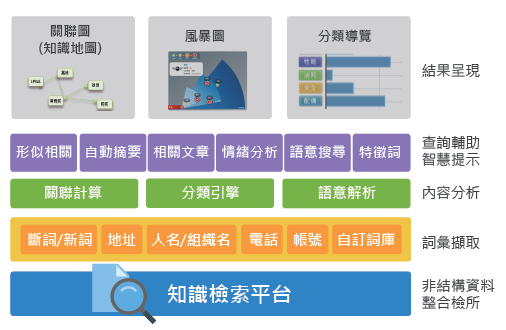Explore semantic analysis technologies to quickly grasp the key content.
With eLAND’s deep learning semantic analysis technology, you can quickly extract the key contents from complex and unstructured textual data.
Explore semantic analysis technologies to quickly grasp the key content.
With eLAND’s deep learning semantic analysis technology, you can quickly extract the key contents from complex and unstructured textual data.
— Main Features —
Content Feature Extraction
Through deep learning, DeepNLP automatically analyzes unstructured textual data to extract feature words related to the main theme of the articles.
Sentiment Analysis
Utilizing an AI sentiment model, DeepNLP calculates overall positive, negative, and neutral sentiment scores of the article to understand the conveyed emotional tone.
Content Summarization
Simplifying the text content and identifying key words to extract essential sentences or paragraphs, generating a summary of the text.
Feature Attribute Analysis
Automatically categorizing the extracted feature words based on attributes, such as addresses, names, organizations, etc.
Part-of-Speech Analysis
Utilizing deep learning technologies to perform “lexical segmentation” and “part-of-speech tagging,” facilitating the subsequent use of qualitative text for quantitative statistics.
Get Access to the Experimental New Feature
Operational Architecture
The Tornado Semantics Analysis Platform includes two key features: DeepNLP Text Miner and DeepNLP Classifier. These are crafted to mimic human cognitive processes for analyzing unstructured text.
Moreover, the platform can integrate with non-structured data through the Tornado Search KM System. It utilizes Natural Language Processing(NLP) to extract essential keywords, analyzes content features and connections, and executes advanced functions like sentiment analysis and automatic classification. The results are then visually presented, allowing users to easily identify crucial information hidden within the extensive dataset.

Features
Automatic Extraction
Automatically organizing unstructural data and extracting crucial words, achieving understanding of new terms without the need to create a lexicon.
Association Analysis
Automatically analyzing associations, extending to more documents with similar concepts, providing a more comprehensive theme recommendation.
Sentiment Analysis
Sentiment analysis can be used to evaluate the text's positive and negative emotions and has the flexibility to expand into other semantic dimensions.
Automatic Classification
Automatically categorizing articles to enhance processing efficiency, effectively reducing labor costs.
Learning from Feedback
Equipped with the ability to learn from feedback and improve accuracy by using blacklists and whitelists for result correction.
Applications
Crime Prevention Assistant
Leveraging semantic technology to analyze a wide array of investigative data and files, extracting pivotal keywords, annotating information related to individuals, events, locations, and more. This data is presented with the aid of visualization tools, assisting in analyzing cases from a more intuitive and comprehensive perspective, thus minimizing the possibility of missed clues and aiding in criminal investigation operations.
Suggestions for Marketing Strategies
Conducting semantic analysis of online audience’s browsing behavior to review their website content consumption, and subsequently assigning interest tags. By doing this, ads and product/marketing content can be tailored to people who could be interested in it, thus boosting click-through rates and consequently conversion rates.
Customer Feedback Analysis
Conducting semantic analysis on public complaints or customer feedback, categorizing them by type, and automatically assigning them to respective responsible units. Additionally, the system can automatically calculate their sentiment scores, extract keywords, and assist in evaluating the situation, forming response strategies and contingency plans.
Local Government Petition Analysis
Conducting semantic analysis on petition cases, extracting key terms, personnel, time, location, and other information. Automatically assigning them to responsible units, summarizing important issues within, and conducting related statistics on petition cases and crucial topics to expedite government processing and strategy formulation.
Enhancing Contents
Utilizing NLP semantic analysis technology to replace manual classification, process unstructured data, and extend more related concepts based on article content. Enriching reading quality and enhancing user engagement.
Creating Knowledge Maps for Enterprises
Assisting enterprises in analyzing internal data, summarizing and classifying it based on content, generating summaries, and establishing a dedicated knowledge map. Users can save time on repetitive reading and reading errors, and extend to more complete content, enhancing overall efficiency and making more comprehensive plans.
Copyright eLAND Information Co., Ltd.